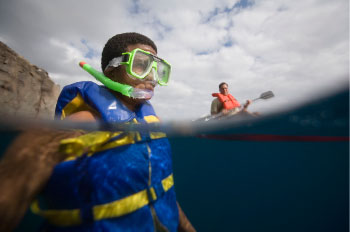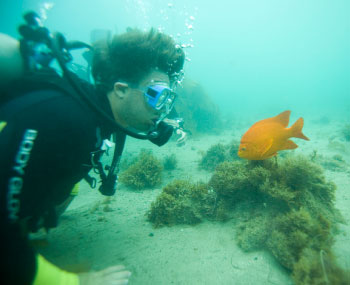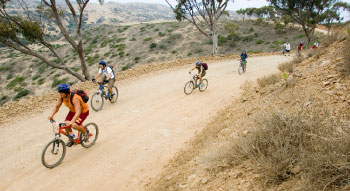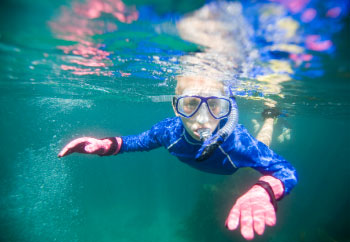A Rugged Adventure
By Douglass K. Daniel
Photographs by Corey Rich
Underwater and overland, older Scouts and Venturers discover challenging new programs at Catalina Island's Camp Emerald Bay.
Fifteen feet below the Pacific Ocean’s quiet surface near what is officially Santa Catalina Island but often called just Catalina Island, dim rays of light illuminated the orange glow of a gliding garibaldi, the state marine fish of California.
 As part of a weeklong Rugged Adventurers program operated by the Western Los Angeles County Council, Ryan Hailey of Troop 733, Brea, Calif., snorkles in the waters off of Catalina Island while assistant Scoutmaster Jesse Jones paddles a kayak nearby. |
The footlong garibaldi stopped moving when it spied a creature alien to its watery world. Its saucer-shaped eyes followed air bubbles drifting upward and then turned to stare at the source—a scuba tank strapped to the back of Van Whiting, an assistant Scoutmaster with Troop 271 in San Diego.
Then the garibaldi swam toward Whiting’s diving buddy, Jonathan Howard, an Eagle Scout with Troop 131 in Palm Desert, Calif. Jonathan drew the fish’s attention by slowly tracking his finger before it.
Snap! With lightning speed, the garibaldi jerked its head forward and closed a set of tiny teeth around Jonathan’s finger. Startled, the Scout snatched back his hand, his finger feeling only a slight pinch.
“It was in a playful mood,” Whiting said later, after pulling off his scuba gear. “We were in his environment, in his home.”
It’s another story to take back home from the new Rugged Adventurers program at Camp Emerald Bay. In addition to its Boy Scout summer camp sessions, the 82-year-old camp on Catalina Island is now home to four high adventure opportunities designed exclusively to attract older Boy Scouts and Venturers.
Leaders for a lifetime
Some Boy Scouts drift away from their troops as they advance in rank and enter high school. With plenty of competition for their leisure time, teens want—and troop leaders need—activities that attract high interest and still deliver Scouting’s core principles.
 Assistant Scoutmaster Van Whiting of San Diego Troop 271 goes eye-to-eye with a garibaldi. |
While developing a separate high adventure camp program for Scouts 14 and older, Emerald Bay’s executive director Lee Harrison focused on Scouting’s mission statement—preparing young people for a lifetime of ethical choices—as well as an exciting high adventure experience.
The program that Harrison, camp director Kirk Hetherington, and others created highlights Emerald Bay’s special opportunities for scuba diving, oceanography, hiking, biking, and canoeing. Equally important is the program’s emphasis on leadership and making good decisions.
“This isn’t just Scouting warmed over,” said Ross A. Harrop, Scout executive of the Western Los Angeles County Council. “This program is something fresh and challenging for an older teenager. It is a laboratory for ethics and leadership training while the teenagers are having a challenging adventure.”
Something tough and different
For a week last summer, Zach Jongema and Alex Mang were among 30 or so adventurers in Rugged Explorers—or Rugged E—one of the camp’s four new programs.
“I wanted to do something different,” said Zach, 14, a Life Scout with Troop 1509 in Alexandria, Va., his mountain bike resting under a palm tree. “We’re getting to do things the younger Scouts can’t do. The new boys look up to you and say, ‘Oh, I can’t wait until I can do that.’”
 One of the Rugged Adventurers programs includes a multiday mountain bike tour through the sunbaked hills of Catalina Island. |
Added 15-year-old Alex, a Star Scout from Troop 321 in Mission Viejo, Calif.: “I think I’d be bored just sitting around in camp. I’ve gone to camp to work on lots of merit badges, but I’m a pretty active person. I probably wouldn’t come here if this was just the same old camp program.”
Rugged E doesn’t allow for sitting around. In one week the Scouts paddled war canoes—craft that are at least 22 feet long and can hold six or more people—for 16 miles in the sometimes choppy waters surrounding Catalina. They covered 48 miles of rough roads on mountain bikes. A seven-mile hike took them to one of the island’s highest peaks, and they still had time to snorkel in some of the island’s coves.
“We wanted to do something new,” said Logan Adams, 16, a Life Scout with Team 578 in Agua Dulce, Calif. “And this has been a lot harder than I’d thought.”
Not that he didn’t get help. Camp Emerald Bay supplied the food, the gear, and the guides for each day’s activities, allowing Logan and the other Scouts to focus on their physical and leadership goals.
A daily dose of values
Lessons in leadership make up a prime ingredient of Rugged E and the other Rugged Adventurers programs. The Scouts were divided into eight-person crews, and they prepared written goals and guidelines to adhere to as a crew and as individuals. Each day a new core value, such as trust, teamwork, and service, was examined and discussed.
 The Rugged Canoers program includes a 60-mile circumnavigation of Catalina Island. Breaks for snorkeling ease sore muscles. |
Experienced camp staff helped with everything from biking a mountain road to making choices.
“We’re constantly coaching,” said Dusty Rael, the high adventure director at Camp Emerald Bay. “The staff is there to help them develop a process for making decisions.”
The Rugged E adventurers needed the staff’s encouragement as they hiked three and a half miles to the top of Silver Peak, at 1,804 feet the island’s second-highest mountain. They kept pushing and pushing, watching out for loose rocks and even pulling themselves up the walls of a dry riverbed.
“It was much more mentally challenging than just going up a trail,” said Chris Gurley, 15, a Life Scout with Troop 2000 in Carlsbad, Calif. “It seemed like it would never end, and then we finally got there—yes! Reaching the end of the journey was the best part.”
From Silver Peak, the Scouts could view the entire island—and the ocean on both sides. Cooled by the wind and slow-moving clouds, Chris felt as though he were in a different world. And the next day would bring yet another challenge: biking up 2,069-foot Mount Orizaba, Catalina’s highest point.
Before that, the Rugged E’s enjoyed a swim in one of Catalina’s many bays. Resting on the sand, Chris looked out at the breaking waves. “This,” he said, “has definitely been one of the roughest weeks of my life.”
Nature’s own laboratory
The Rugged Scuba and Rugged Oceanographers programs provide a different kind of challenge.
In Rugged S, Scouts work toward basic scuba certification. Rugged O teaches skills required for advanced scuba certification, which allows the participants to dive in deeper water. They also take turns as leader and as dive master of the day, and they develop their own research projects.
“It’s a natural laboratory,” said Marc Duncan, the marine science director at Camp Emerald Bay and the director of Rugged O. “We look at marine life and different marine environments around Catalina Island. We develop skills the first half of a dive and identify marine habitats the second half.”
Scuba diving involves a lot of dry work, too. In the camp’s Pennington Marine Science Center, Scouts learn about conservation, preserving habitats, and respecting marine life while exploring the ocean. They plan every dive to the minute, maintain dive logs, and dissect each dive at day’s end.
The night before a deep dive, Duncan reminds a scuba class how to stay safe in a different atmosphere, a place without air, where a mistake can be fatal. Terms like “nitrogen narcosis”—a brain-fogging buildup of gas that divers call “the rapture of the deep”—become part of their vocabulary. Knowing exactly how much air is left in a tank and how long it will take to surface is the difference between life and death.
“You have to be on the money,” Duncan tells the Scouts. “When deep-diving, you have to be self-disciplined. You have to build up your experience level and your confidence gradually.”
Where everyday is awesome
In black wetsuit and other gear, Preston Luna plunges into the Pacific to join his diving buddy. In seconds the 16-year-old Eagle Scout with Mission Viejo’s Troop 321 is surrounded by marine life, from a big bat ray to a leopard shark and a moray eel.
Just outside a thick patch of kelp, Preston pauses to take in his surroundings. Then he watches as a footlong octopus bolts from a hole to catch a fish.
“That’s something you don’t see every day,” Preston said later. “Maybe on the Discovery Channel, but here, it’s happening right in front of you.”
One of his Troop 321 buddies, Life Scout Matt Berry, 16, added: “I really like that there’s a whole other world under the water. When you scuba dive, you become part of that.”
Rugged Canoers, like those from Venturing Crew 007 in Newton, Kan., leave Catalina with an indelible memory of the island—and sore muscles. After all, they paddled its entire coastline, a nearly 60-mile circumnavigation with time for hiking and snorkeling.
Within minutes of pulling their canoes ashore, the Rugged C’s from Kansas celebrated atop the Arrow Point promontory northwest of camp. The view was just the spot for high-fives and farewells.
“It’s fun, and it’s rugged,” said crew member and Eagle Scout Jordan Sharp, 19, “and you have a great time.”
Douglass K. Daniel is an editor in the Washington, D.C., bureau of The Associated Press. For information on Camp Emerald Bay’s Rugged Adventurers, see http://www.bsa-la.org/camping/eb/RA_2007_Participant_Guide.pdf or call (818) 933-0130.
ON THE WEB: To see other high adventure programs available at local Scout councils nationwide, go to the searchable directory at www.scouting.org/boyscouts/directory/index.html.
Camp Emerald Bay: Scouting by the SeaThe conservation-minded William Wrigley Jr. (Chicago’s chewing-gum magnate) purchased Santa Catalina Island in 1919. To control the island’s development, he found the Boy Scouts to be a willing partner in conservation. Camp Emerald Bay was established in 1925 as a small Scout camp and Sea Scout base. The U.S. Navy upgraded facilities in the 1940’s when the camp was turned into a Seabee training base during World War II. That called for the construction of barracks and other buildings still in use. One of the camp’s earliest boosters, George M. Pardee Jr., helped expand facilities even more in the late 1950’s and early 1960’s. A substantial grant from George M. and Katherine Pardee, for whom the camp was dedicated in 2000, funded more recent improvements. The camp now accommodates 500 Scouts and 100 staff members each week for summer activities. Visitors can enjoy canoeing, boating, snorkeling, archery, riflery, and working with leather, wood, and clay in a craft shop. A million-dollar marine sciences and biology research and education laboratory—the Pennington Marine Science Center—pulls together the Wrigley and BSA visions of conservation and appreciation of natural habitats. During the off-season, the camp is available to non-Scouting groups. Camp Emerald Bay’s first Scouts probably wouldn’t recognize the place, except for the ever-lapping waters along its shoreline and the nearby hills. One camp feature, though, is a giveaway: Catalina Island’s largest tree, a blue gum eucalyptus that may be as much as 130 years old. —D.K.D. |
A Lasting LegacyMike Lanning has been bringing his Scout troop to Camp Emerald Bay for more than 50 years. As Scoutmaster of Troop 223 in Pacific Palisades, Calif., since 1954, Lanning has guided thousands of Scouts. (More than 550 have earned their Eagle Scout Awards.) And Lanning has devoted countless hours to developing leadership-based programs and to fund-raising that has fueled Camp Emerald Bay improvements. During its week at summer camp, his troop conducts its own youth leadership training program. Recognizing the changing demands of Scouts for challenging activities, Lanning has contributed many ideas for older boy programs, such as Rugged Adventurers, that will ensure that more Scouts will keep coming to the camp for the next 50 years. “I think my legacy for Camp Emerald Bay is helping to develop a program that prepares skilled, ethical leaders for tomorrow,” Lanning says. “You take this property’s incredible natural resources and use it to inspire boys.” Both Lanning and Camp Emerald Bay have enjoyed the support of other Scout volunteers, generous moms and dads, and the Western Los Angeles County Council, led by Scout Executive Ross A. Harrop. “A lot of care and nurturing by each Scout executive has helped us volunteers realize our vision,” Lanning says. “Ross gives us free reign to exercise our passion.” To honor Lanning as well as the Scouts, assistant Scoutmasters, and parents, Camp Emerald Bay dedicated the Troop 223 Plaza last summer. With the completion of this latest camp improvement, the plaza will be a gathering place for the next generation of tomorrow's leaders. —D.K.D. |
May - June 2007 Table of Contents
Copyright © 2007 by the Boy Scouts of America. All rights thereunder reserved; anything appearing in Scouting magazine or on its Web site may not be reprinted either wholly or in part without written permission. Because of freedom given authors, opinions may not reflect official concurrence.